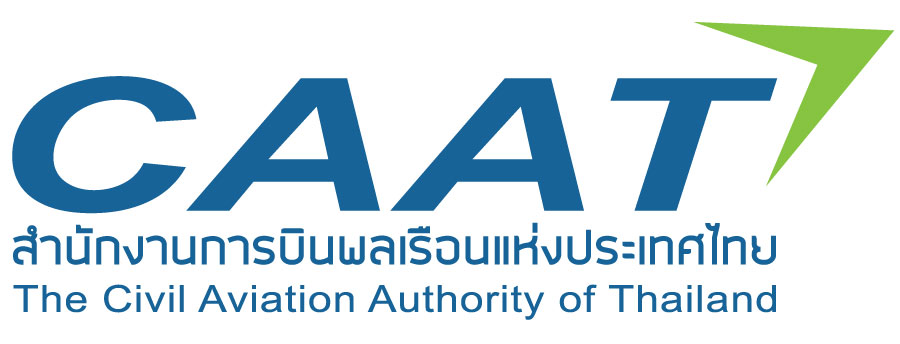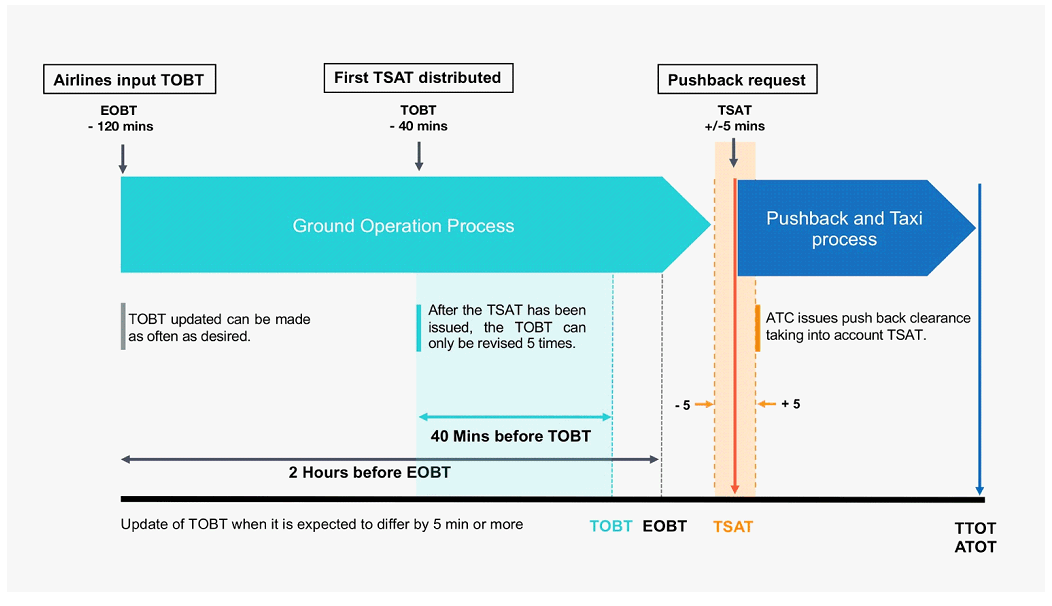3.1 Suvarnabhumi A-CDM Procedure Overview
The chart below describes the simple overview of the Pre-Departure process at Suvarnabhumi International Airport from the time that airlines input the TOBT to the time that aircraft is airborne. It includes the responsibilities and procedures in brief, as described below.
3.2 Target Off-Block Time (TOBT) Procedures
3.2.1 General
The TOBT is the essential contribution of airlines to the A-CDM process which establishes the Pre-Departure Sequence taking into account operators preferences and operational constraints. Airlines or person responsible for the TOBT are required to access and manually input the TOBT into the A-CDM Portal in order that the start-up approval time (TSAT) can be expected.
3.2.2 Person Responsible for TOBT
Airline operator (AO) is responsible for the input of and adherence to the TOBT. However, AO may prefer to delegate this function to ground handler (GH). It is the responsibility of the AO/GH to communicate and ensure that the pilot of a flight has the correct TOBT and TSAT prior to requesting ATC clearance.
AO need to ensure that a timely, accurate and stable TOBT is provided. If it becomes obvious that the TOBT cannot be respected, it shall be updated by the person responsible for the TOBT as early as possible.
3.2.3 TOBT Input and Revision
The following has to be taken into account for the input and/or revision of the TOBT:
-
The first TOBT can be input at 120 minutes (2 hours) prior to EOBT.
-
A TOBT input must be at least the present time.
-
The TOBT revision can be made as often as desired until the TSAT has been issued (40 minutes prior to TOBT).
-
After the TSAT has been issued, the TOBT can only be revised not more than 5 times to ensure a stable operation.
-
New TOBT must differ by at least 5 minutes (+/-5 minutes) from the latest input TOBT to protect a stable Pre-Departure Sequence.
3.2.4 Flights with Calculated Take-Off Time (CTOT)
Flights with CTOT will usually take priority when calculating TSATs in order to minimize potential CTOT delay.
3.2.5 TOBT Deletion
-
TOBT can be deleted by users with permission to input/revise the TOBT.
-
If the TOBT is deleted, the TSAT is automatically deleted.
-
The TOBT has to be deleted in the following cases:
-
TOBT is unknown (e.g. technical problems with the aircraft), or
-
The permitted number of TOBT revision (5 times) after the generation of the TSAT has been exceeded.
-
If a new TOBT is known, the process shall continue and the person responsible for the TOBT has to enter a new TOBT.
3.2.6 TOBT Reporting Channels
The TOBT is reported or updated by the following ways:
-
A-CDM Portal Web Based Application (https://acdm.airportthai.co.th/)
-
A-CDM Portal Mobile Application
3.4 Start-Up and Push Back Procedures
3.4.1 General
Start-up and push back approval are issued taking into account the TOBT and TSAT. The sequence of the start-up and push back request is no longer a factor. The following rules apply:
3.4.2 Start-Up and Push Back Procedures
3.4.2.1 Pilot shall ensure that aircraft is ready for push back at TOBT.
3.4.2.2 After obtaining ATC clearance, pilot shall monitor defined ground control frequency in accordance with aircraft parking stand. If there is any change of TSAT, Ground Control will update the pilot as soon as possible.
3.4.2.3 The pilot shall contact Ground Control for start-up and push back at TSAT +/- 5 minutes (TSAT window). These three scenarios may occur:
-
Before TSAT window: Flight will be requested to call again when it is within the TSAT window.
-
Within TSAT window: Flight will be planned for outbound sequence and may expect start-up approval directly or within a few minutes depending on actual operational situation
-
After TSAT window: The TSAT of the flight has expired. Flight will be denied start-up approval. Pilot has to contact its AO/GH to update the TOBT and shall contact ATC again when TOBT update has resulted in an updated TSAT.
3.4.2.4 Ground Control will issue start-up and push back clearance taking TSAT into account.
3.4.2.5 If a flight is unable to push back due to the aircraft being unready, TSAT will be cancelled. Pilot must notify the AO/GH to update the TOBT for a new TSAT.
Note: When a departing aircraft is occupying a gate that has been assigned to an arriving aircraft, the departing aircraft may be instructed by ground control to push back onto the taxiway without engine start-up to allow the arriving aircraft to taxi in. An Expected Taxi Time will be provided accordingly.

